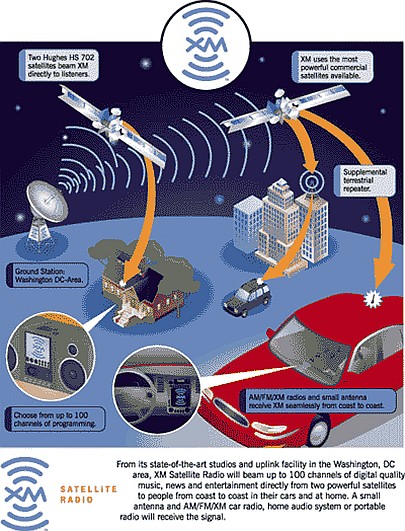Satellite Radio Systems
Satellite radio is an idea over a decade in the making. In 1992, the U.S. Federal Communications Commission (FCC) allocated a spectrum in the “S” band (2.3 GHz) for nationwide broadcasting of satellite-based Digital Audio Radio Service (DARS). Only four companies applied for a license to broadcast over that band. The FCC gave licenses to two of these companies in 1997. CD Radio (later Sirius Satellite Radio) and American Mobile Radio (later XM Satellite Radio) paid more than $80 million each to use space in the S-band for digital satellite transmission.

- Sirius XM Radio
- 1worldspace
Satellite radio companies are comparing the significance of their service to the impact that cable TV had on television 30 years ago. Listeners aren’t able to pick up local stations using satellite radio services, but they have access to hundreds of stations offering a variety of music genres. Each company has a different plan for its broadcasting system, but the systems do share similarities. Here are the key components of the two satellite radio systems:
- Satellites
- Ground repeaters
- Radio receivers
Satellite radio works a lot like satellite TV — you purchase a receiver and pay a monthly subscription fee for a certain number of channels. For the moment, there are slight variances in the three satellite radio companies’ systems. In the next three sections, we will profile each of the companies and their current satellite radio services.
XM Radio
While XM Radio and Sirius have merged into a single company, the two services aren’t fully integrated yet. Part of the reason for this is due to differences in hardware and software.
XM Radio uses two Boeing HS 702 satellites, appropriately nicknamed “Rock” and “Roll,” and two BSS 702 satellites it calls “Rhythm” and “Blues,” placed in parallel geostationary orbit, two at 85 degrees west longitude and the other two at 115 degrees west longitude. Geostationary Earth orbit (GEO) is about 22,223 miles (35,764 km) above Earth, and is the type of orbit most commonly used for communications satellites. The first XM satellite, “Rock,” was launched on March 18, 2001, with “Roll” following on May 8 of the same year. A design flaw in the HS 702 satellite caused its solar panels to function inefficiently. XM launched “Rhythm” on February 28, 2005, and “Blues” on October 30, 2006, to replace the older satellites. Then XM Radio powered down “Rock” and “Roll.” The older satellites remain in orbit and can serve as backups, if necessary.
XM Radio’s ground station transmits a signal to its two active GEO satellites, which bounce the signals back down to radio receivers on the ground. The radio receivers are programmed to receive and unscramble the digital data signal, which contains more than 170 channels of digital audio. In addition to the encoded sound, the signal contains information about the broadcast. The song title, artist and genre of music are all displayed on the radio. In urban areas, where buildings can block out the satellite signal, XM’s broadcasting system is supplemented by ground transmitters.
Each receiver contains a proprietary chipset. XM began delivering chipsets to its XM radio manufacturing partners in October 2000. The chipset consists of two custom integrated circuits designed by STMicroelectronics. XM has partnered with Pioneer, Alpine, Clarion, Delphi Delco, Sony and Motorola to manufacture XM car radios. Each satellite radio receiver uses a small, car-phone-sized antenna to receive the XM signal. General Motors has invested about $100 million in XM, and Honda has also signed an agreement to use XM radios in its vehicles. GM began installing XM satellite radio receivers in selected models in early 2001.
Currently, subscribers can receive the regular XM channel lineup for $12.95 per month. For that price, listeners get more than 170 channels of music, talk and news. They also get access to XM Radio online, a streaming audio service with more than 80 channels. Many of the channels have no commercials, and none of the channels have more than seven minutes of ads per hour. XM’s content providers include USA Today, BBC, CNN, Sports Illustrated and The Weather Channel. The service bolsters that lineup with its own music channels.
For more Detail: How Satellite Radio Works
